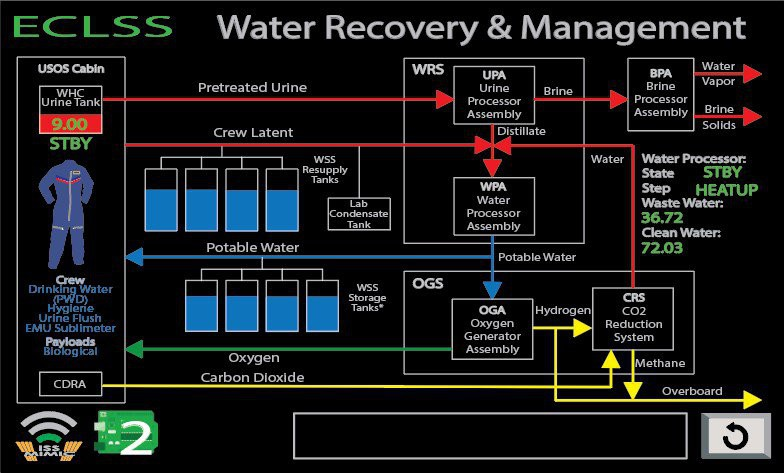ISS Mimic Brings Space Station Down to Earth [Hackaday]

Built at a cost of more than $150 billion over the last twenty-five years, the International Space Station is arguably one of humanity’s greatest engineering triumphs. Unfortunately, unlike Earthly construction feats such as the Hoover Dam, Burj Khalifa, or the Millau Viaduct, you can’t visit it in person to really appreciate its scale and complexity. Well, not unless you’ve got the $50 million or so to spare to buy a seat on a Dragon capsule.
Which is why the team behind the ISS Mimic project are trying to make the ISS a bit more relatable. The open source project consists of a 3D printable 1:100 model of the Station, which is linked to the telemetry coming down from the real thing. A dozen motors in the model rotate the solar arrays and radiators to match the positions of their full-scale counterparts, while LEDs light up to indicate the status of various onboard systems.
To learn more about the ISS Mimic, team members Bryan Murphy, Sam Treadgold, and Tristan Moody stopped by this week’s Hack Chat to bring us up to speed on the past, present, and future of this fascinating project.
Sifting Through the Data
Bryan and Sam both worked to support the real ISS at NASA, which gave them a unique insight into the Station’s daily operations. They also were well acquainted with the ISS telemetry feeds being beamed down to Earth from the Tracking and Data Relay System Satellites (TDRSS). These are made available to the public, and NASA even offers a few official ways to visualize and interact with the data. But the team thought there was potential to make all those rapidly changing fields of data come alive in a way that hadn’t been done before.
Wrapping the raw telemetry data up into visually exciting status pages gives important context, and turns what’s essentially a spreadsheet into something that looks like it could be out of a video game — something that’s particularly appealing to younger audiences. With a Raspberry Pi and small display, users are able to quickly flip through a collection of these status pages that cover a wide range of Station functions.
Building the Model
While the visualization screens are already a big improvement over the raw telemetry data, the ISS Mimic project is really about the 3D printed model itself. The team has been working on recreating each and every module of the Station in CAD — first in a “LoFi” version which is little more than a properly sized cylinder, and then later on, a high resolution version that includes accurate surface details. Where applicable, modules use magnets so they can be easily attached and potentially rearranged if needed.

Ultimately, the goal is to have schools and other institutions build their own ISS Mimics, so keeping things as cheap and simple as possible is the name of the game. In fact, in response to the feedback they got from teachers, the team is currently working on a “Mini Mimic” that’s half as large and easier to print and assemble. This smaller version is still in development, but has already been assembled by a few schools over the summer.
Sam mentions that the team is also looking into more ways to make the model come alive. One suggestion was to add appropriately positioned LEDs that will blink when the Station is firing its maneuvering thrusters. He’d also like to add the Mobile Servicing System, a robotic platform that moves along a railway that stretches the length of the Station’s main truss. Like the solar arrays and radiators, this would be motorized so synchronize its position on the model with the real-world version in orbit.
Towards the end of the Chat, it was suggested that the Hackaday community should build its own ISS Mimic. Various modules and systems could be assigned to volunteers, and then the final model could be assembled during Supercon. With less than a month to go before we convene in Pasadena on November 3rd, it’s not something that we’d be able to pull of this year. But of course, there’s always 2024…
We’d like to thank Bryan, Sam, and Tristan for joining us in the Hack Chat and answering the community’s questions about this ambitious endeavour. We’re excited to see where the ISS Mimic goes from here, and will keep a close eye on its development. Since a trip to the real Station seems out of the question, this might just be the next best thing.
The Hack Chat is a weekly online chat session hosted by leading experts from all corners of the hardware hacking universe. It’s a great way for hackers connect in a fun and informal way, but if you can’t make it live, these overview posts as well as the transcripts posted to Hackaday.io make sure you don’t miss out.

![iss-mimic-brings-space-station-down-to-earth-[hackaday]](https://i0.wp.com/upmytech.com/wp-content/uploads/2023/10/145987-iss-mimic-brings-space-station-down-to-earth-hackaday.jpg?resize=800%2C445&ssl=1)
